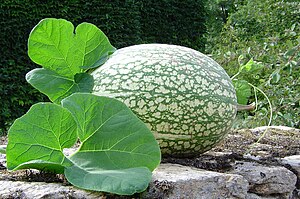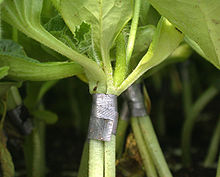Fig leaf pumpkin
| Fig leaf pumpkin | ||||||||||||
|---|---|---|---|---|---|---|---|---|---|---|---|---|

Fig leaf pumpkin ( Cucurbita ficifolia ) |
||||||||||||
| Systematics | ||||||||||||
|
||||||||||||
| Scientific name | ||||||||||||
| Cucurbita ficifolia | ||||||||||||
| Bouché |
The fig leaf gourd ( Cucurbita ficifolia ), also called cayote , is a species of the cucurbit family (Cucurbitaceae). Of the five cultivated pumpkin species, it has the least significance.
features
The fig leaf gourd is a prostrate or climbing annual plant . It lasts for some time and can give the impression of a short-lived perennial plant. It has no reserve roots. The whole plant is rough to softly hairy, in the vegetative parts also covered with sharp spines. It usually has five rungs with slightly angular stem axes . The leaves have stems 5 to 25 centimeters long. The blade is egg-heart-shaped to almost round. The surface can have white spots. The blade has three to five rounded or slightly pointed lobes, the middle one being larger than the lateral ones. The leaf margin is serrated. The tendrils are three to four parts.
The flowers are solitary in the leaf axils. The male flowers are long stalked, have a bell-shaped calyx 5 to 10 millimeters long and almost the same width. The crown is bell-shaped with a broad base. It is 6 to 12 inches long, yellow to pale orange. The female flowers have a three to five centimeter long peduncle. The ovary is elliptical ovate to. The sepals are sometimes green and leaf-like, the crown is slightly larger than that of male flowers.
The fruit is round to oval-elliptical. There are three color swatches: light or dark green with or without elongated white lines or stripes on top; spotted white and green in small areas; white, creamy white or fleshy white. The hard skin is 3 - 5 mm thick and is sharply defined from the pulp. This tastes slightly sweet, but has no taste of its own. It contains few vitamins and minerals, modest amounts of carbohydrates and, as can be seen from the white meat, unlike many other pumpkins, almost no β-carotene . The seeds are oval-elliptical, flat and measure (15 to 25) × (7 to 12) millimeters, are dark brown to black or creamy-white in color and distributed in the flesh. They are rich in oils and proteins. Ripe fruits can be stored for several years.
The number of chromosomes is 2n = 40.
Distribution and ecology
For a long time it was assumed that the fig-leaf pumpkin is native to Asia . One of its common names is Malabar pumpkin. Like the other types of pumpkin, however, it comes from America. The species is only known in culture, wild forms are not known. The area of origin is possibly in the plateau of Mexico , the Andes are also being discussed. The cultivation area ranges from northern Mexico to Argentina and Chile . In the 16th or 17th century the species came to India , France and Portugal . From there the cultivation spread to Japan , the Philippines and other European countries.
Systematics
The fig leaf pumpkin has no commercial cultivars. It cannot be crossed with other types of pumpkin.
Cultivation
The fig leaf gourd is grown in a large geographical area, but is limited to the altitude ranges between around 1000 to almost 3000 m. This distinguishes it from the other species of the genus, which are also grown in much lower altitudes. It is grown in all mountain regions in Latin America.
It is mostly grown in areas with high rainfall and sown at the beginning of the rainy season. The harvest takes place between September (for young fruits and flowers) to December and January (ripe fruits). In some areas of Mexico it is grown on wetter soils even in the dry season. It is planted together with other traditional crops such as corn , beans or other pumpkins in fields or in vegetable gardens. The species tolerates low temperatures, but not severe frosts. Propagation takes place exclusively through seeds. These can be kept for 18 to 20 months, and the ripe fruits can also be stored for a long time.
use

The use of the different parts of the plant is quite diverse. Unripe fruits are eaten cooked as vegetables. The pulp of the ripe fruits is processed into sweets, soft drinks and alcoholic beverages. The seeds are also eaten. In Chiapas they are processed with honey to make palanquetas desserts . In Mexico, young shoot axes and flowers are also used as cooking vegetables. The ripe fruits are fed to the cattle.
The fig leaf pumpkin is used as a base for various cucurbits due to its Fusarium resistance . It is particularly widespread in cucumber production in glass houses. The cucumber plants also become 3 ° C more cold-tolerant.
literature
- R. Lira Saade, S. Montes Hernández: Cucurbits . In: JE Hernández Bermejo, J. León (Ed.): Neglected crops. 1492 from a different perspective . FAO Plant Production and Protection Series No. 26, Rome 1994, pp. 63-77. ISBN 92-5-103217-3 (online1) (online2)
Individual evidence
- ↑ Cucurbita ficifolia at Tropicos.org. In: IPCN Chromosome Reports . Missouri Botanical Garden, St. Louis
- ↑ Bavarian State Institute for Viticulture and Horticulture ( Memento of the original from March 15, 2014 in the Internet Archive ) Info: The archive link was inserted automatically and has not yet been checked. Please check the original and archive link according to the instructions and then remove this notice. Processed vegetables



